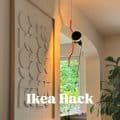I thought we’ll go arty today and feature some “art” accomplished through IKEA pieces. I don’t fully understand them (because I am a really practical person?) but maybe some of you out there will. That said, I do appreciate the kind of extreme thinking IKEA inspires. It’s also fun to see how far out IKEA can go. So, ladies and gentlemen, I present to you a series of Lack side tables that transforms into floors and shelter and a modular art piece from SODA straws. ~ Jules
Transformer floor
Materials: 10 Ikea Lack side-tables, plastic foam, textile rope, glue gun, glossy paint, drills and needles
Description:
1. Paint and drill:
Take 10 (or moore) Ikea LACK side-
tables. Paint the underside with a glossy black paint. It should be a Specular gloss and almost work as a mirror. Paint two of each sides of the legs.
Drill holes from the side. Place plastic foam inside the cavaties to make them more confortable.
2. Hinge them together:
Use the legs as a hinge. Drill holes (3mm) diagonally through the legs as shown in the drawing. Drill holes on the sides of the table tops.
Buy a long thin needle and stitch the legs and the table tops together with one continuous thread for each hinge. This hinge makes it possible to bend it in two directions.
You can connect the table-tops as you wish. In my example they are connected like a coiling snake.
3.Plastic foam:
use a glue-gun to glue the plastic foam on upside of the new floor. Make cuts in the foam to create openings where you can hide, store or hang things in.
Finished!
This is a floor that can flip or unfold in various ways. You can build a new table, a bed, a shelter, a hiding place, a wall etc …, …
~ Kristina Sundin, Stockholm
Intrinsic Formal Value of 5000 IKEA SODA Straws
Materials: SODA Straws
Description: A work of modular art consisting of 5000 units; in this case IKEA straws.
The work was created simply by connecting the end of one straw to the other by friction. Pinching one end would allow the straw to fit tightly into the next.
The entire process was meticulously documented and recorded, over 25 hours of footage captured.
It was imperative to the concept that I stood in the exact same spot while I produced it, in order to achieve the most natural form. I am studying the Intrinsic formal value of the single unit. Where most modular artists arrange their units in arbitrary ways, I am compelled by the material to interfere with its inherent form as little as possible.
~ Adam Frank, Waterloo, Ontario, Canada










